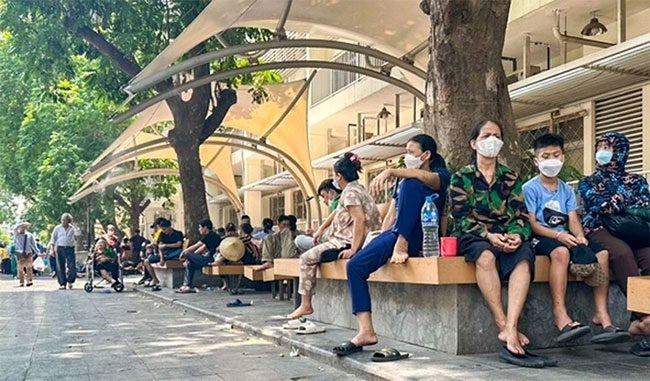Many people believe that when the weather is hot, staying in the shade can prevent sunburn.
In reality, this is not entirely true. The UV rays from the sun can still be reflected by the ground and affect us or even diffuse into the atmosphere.
Therefore, when the intensity of UV rays is high, standing under a tree or using an umbrella can still lead to sunburn.
In the long term, frequent sunburn can increase the risk of developing skin cancer.
To understand this issue clearly, we first need to know how sunlight works.

The ground can still reflect solar radiation even when we are avoiding direct sunlight in the shade (Illustration: Nguyễn Hải).
The sun is over 150 million kilometers away from Earth, continuously emitting various types of rays, including infrared, UVA, UVB, UVC, X-rays, gamma rays, and even radio waves.
Among these, UVC rays, X-rays, and gamma rays are absorbed by the ozone layer, which is located about 30 km above Earth and acts as a shield to protect the environment, climate, and living organisms.
However, the remaining radiation can still penetrate this protective layer and come into contact with us.
Radio waves that reach our planet are harmless, but infrared, UVA, and UVB rays can affect our skin.
Specifically, infrared rays penetrate deeply into the skin and create a warming sensation, while UVA rays affect the dermis, accelerating the aging process and forming wrinkles on the skin.
Finally, UVB rays penetrate deeper into the epidermis, leading to tanning (a natural response that helps protect the skin) or sunburn.
The Ground Reflects UV Rays
We often avoid sunlight by standing under trees or using umbrellas.
This method can effectively block direct sunlight. However, the ground, roads, etc., reflect a significant amount of ultraviolet radiation, which then disperses into the atmosphere.
According to the World Health Organization (WHO), some surfaces can reflect ultraviolet rays, such as grass, soil, and water, all reflecting under 10% of UV radiation.
In contrast, sand reflects 15%, and foam reflects 25%.
Notably, the surface of ice and snow can double the amount of UV exposure for people.
This is evidenced by cases of skiers suffering from snow blindness (scientific name: photokeratitis), a form of retinal burn.
In principle, the presence of large clouds in the sky can limit the impact of UV rays reaching us, but these clouds can only reduce this effect.
Additionally, some thin clouds can actually enhance UV intensity by scattering them.
Thus, we cannot be complacent and must still protect our bodies, such as using sunscreen when going outside, even in shady conditions.
Moreover, the windows of buildings should be equipped with UVB and UVA filtering glass, as regular exposure to these rays can lead to skin cancer.
Why Do We Get Sunburned and How Dangerous Is It?
It is important to note that tanning and sunburn are entirely different. Tanning is the body’s natural protective response, formed when we are exposed to solar radiation.
At that moment, melanocyte cells are activated to combat these DNA mutations by releasing additional melanin, which forms a protective layer around vulnerable DNA within skin cells, causing the skin to darken.
In contrast, sunburn is a type of inflammation that occurs when we are exposed to solar radiation for several hours repeatedly, which can lead to the formation of blisters on the skin.
After a few days, the sunburn fades, but it can leave invisible marks that are impossible to erase.
Notably, when the sun shines on our skin, the rays can reach the cells and potentially damage the skin.
Enzymes, with their catalytic properties, are responsible for repairing damaged areas of skin on the body, but they can never fully heal.
Moreover, the more frequently sunburn occurs, the more the DNA is affected. The cells that read DNA multiply to create defective cells, posing a long-term risk of skin cancer.




















































